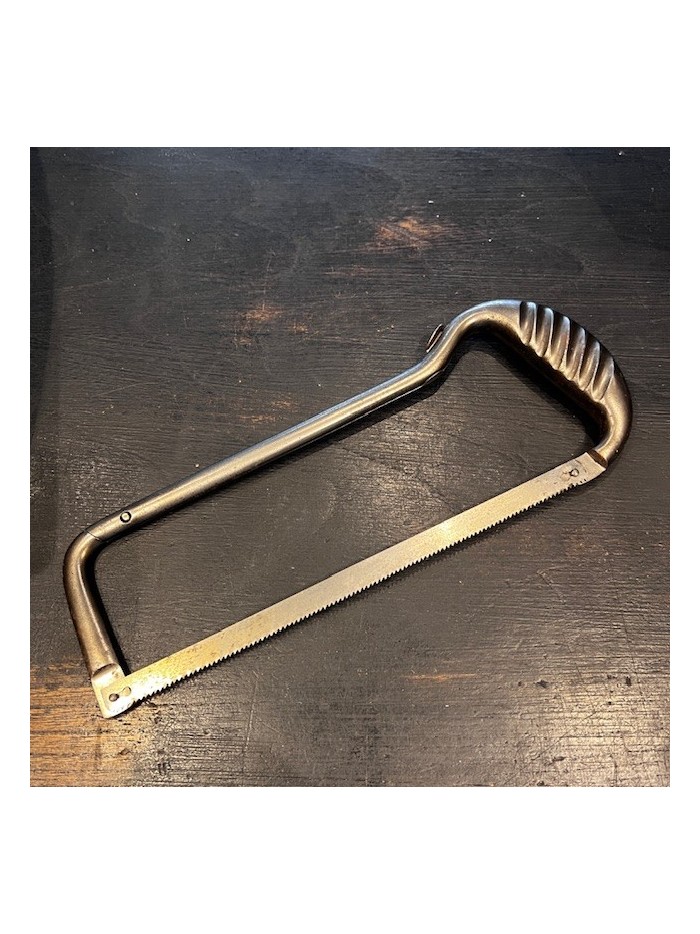
Vegetable-animal liqueur - Antique medicine bottle -...
Vegetable-animal liqueur
Antique medicine bottle
Apothecary







Amputation saw - First half of the 20th century - USSR medical material
Origin: Most likely USSR or Eastern Europe
Estimated time : 1930-1960
Amputation saw from the first half of the 20th century - USSR medical material
Origin: Most likely USSR or Eastern Europe
Estimated period: 1930-1960
Material : All steel (one-piece handle)
Dimensions : Length 25.5cm Height 10cm - Blade length: 21.5cm
Condition: Good condition. Blade present, slight patina from use, functional locking mechanism. No visible markings.
No maker's markings.
Rare surgical amputation saw, made entirely of steel, typical of Soviet or Eastern European production in the mid-twentieth century.
The handle is moulded in one piece, with ergonomic finger grooves for a good grip. This robust, hygienic design was intended for use in hospitals and the military, particularly in field surgery.
The pivoting fly tensioning system or key allows the blade to be replaced quickly, a feature of post-1930 models. The key allows part of the spine to be pulled apart by pressing hard on it. This releases the tension on the blade so that it can be changed. This is a mechanical feature typical of surgical saws made in the Soviet Union or Eastern Europe, where they were industrially manufactured for military or hospital use.
Easy maintenance, quick dismantling, a crude but practical design optimised for greater efficiency and mass production. No manufacturer's markings. All this is typical of Soviet equipment.
Amputation saws of Soviet origin are uncommon to find on the European market.
Vegetable-animal liqueur
Antique medicine bottle
Apothecary
Antique bezoar - Antipoison - Antidote
Once sold by the apothecary, bezoar, also known as gallstone, was reputed to have the same anti-poison properties as the legendary unicorn's horn, hence its excessively high price, also due to its great rarity.
An important piece in a cabinet of curiosities
Sold alone - Without stand, sold separately
Antique pharmacy glass bottle
ROCHE Syrup with Thiocol
Apothecary - Pharmacy
Golden crocodile - Pharmacy corkscrew in cast iron
XIXth century
Bleu de Méthylène
Antique white glass pharmacy bottle - Content: 30ml
Apothecary - Pharmacy
Bulb for hypodermic injection - Camphor (circa 1920)
THERAPLIX
Sparteine sulphate
Used as a tonic for nervous syndromes at the very beginning of the 20th century, sparteine was also used to facilitate morphine withdrawal.
Antique pharmacy bottle
Apothecary vial
Some product left inside
The Anatomy by Heister
Complete with its 14 folding boards at the end of the book
Published in 1735
Antique pharmacy bottle
BIOLACTYL Ferment Fournier - Early 1900
Cinnamon Water
Antique and large brown English pharmacy bottle
Vincent Delabrierre Perfumery
Crème de Lys (Lily cold cream)
Old earthenware ointment jar
19th century
Motto: I make lilies bloom and colour roses
Dr Potain vacuum cleaner in its case
Around 1900
Antique medical instrument from manufacturer GENTILE in Paris
Doctor Louis Jubé pure blood transfusion syringe
For arm-to-arm transfusions
In its metal box
Around 1925/1930
Angelica Archangelica
Pharmacy jar - Herbalism - Apothecary bottle
Late 19th century, early 20th century
Alcool de menthe Raspail
Antique pharmacy bottle
Apothecary vial
EMPTY
Butterfly - Natural History color plate
Entomology
You buy 1 plate, not the whole set

Amputation saw - First half of the 20th century - USSR medical material
Origin: Most likely USSR or Eastern Europe
Estimated time : 1930-1960






